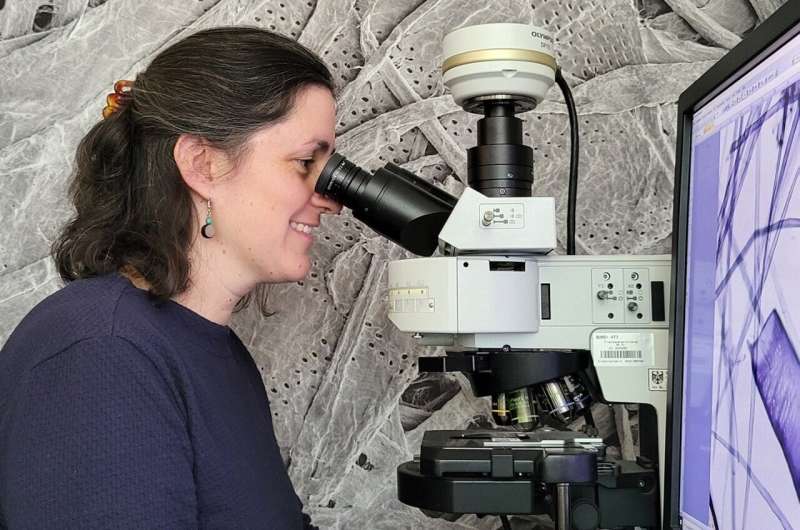This article has been reviewed according to Science X's editorial process and policies. Editors have highlighted the following attributes while ensuring the content's credibility:
fact-checked
trusted source
proofread
Harnessing AI to fight global deforestation

The new European Deforestation Regulation (EUDR) is intended to prevent goods marketed in the EU from contributing to the spread of deforestation. When a wood product is brought into the EU market, for example, there must be documentation of which types of wood were used to produce it, along with proof of their legal origin.
Depending on the material, even the initial review of the declared type of wood is no easy task. Paper, for example, requires time-consuming examination by specialists.
Now, a new AI-based analytical tool for determining wood types is being developed to simplify and accelerate this process. Researchers from the Fraunhofer Institute for Industrial Mathematics ITWM are working closely with the Thünen Institute of Wood Research to develop the automated image recognition system for large-scale review of declarations of wood type.
Illegal logging is one of the consequences of the rising global demand for lumber. The European Union Timber Regulation (EUTR), the predecessor of the EUDR, entered into force back in 2013 with the aim of curbing the unlawful use of wood.
Since then, commercial enterprises have been required to document the types of wood used in their products and their origins, thereby demonstrating the legal origins of the wood used in goods they import into the EU market.
The same applies to wood products such as particle board, fiberboard, paper, and cardboard. But how can the types of wood used in fiber materials be identified without a doubt?
As things currently stand, responsibility for examining wood products falls to people such as the employees of the Thünen Institute, a research institute in the portfolio of the Federal Ministry of Food and Agriculture (BMEL). They receive numerous product samples from industry and government agencies so they can check the types of wood used—and the numbers are rising.
The samples are then sent for expert analysis under a microscope, which is an extremely time-consuming process. With paper and fiberboard, the wood cells are separated from the material, dyed and then prepared on a slide. The cells can then be classified based on their appearance when viewed through a microscope.
But because this preparation and examination process is so time-consuming and more and more samples are coming in for testing, the specialists can only handle a limited number of expert reports.
A new AI-based analytical tool is being developed to help with this situation by relieving some of the workload on highly qualified experts, accelerating and automating the examination process, and enabling fast, efficient controls.
Researchers from Fraunhofer ITWM and the Thünen Institute of Wood Research in Hamburg have teamed up in the KI_Wood-ID project, using machine learning to develop the new automated image recognition system to identify types of wood.

Algorithms to curb the illegal lumber trade
The researchers' first area of focus in the project is hardwoods, especially those originating from plantations grown worldwide for cellulose production. Artificial intelligence can be used to determine the type of wood based on vascular tissue, which varies in cell structure, shape, and size.
Using reference preparations from the Thünen Institute's vast collection of wood samples, the researchers from Fraunhofer ITWM are training neural networks until the AI is capable of independently identifying and classifying the characteristic features of particular species so it can detect the types of wood present in the microscopic image of an unknown sample.
Training for each different category, such as birch, beech, and poplar, takes place separately. In the individual images, the analytical tool first marks the cells that are key to identifying the particular types of wood.
"A sample is considered anomalous if it contains characteristics that don't match the declared types of wood," says Dr. Henrike Stephani, the KI_Wood-ID project manager and deputy head of the Image Processing department at Fraunhofer ITWM in Kaiserslautern.
The overarching goal, she says, is to use AI to strengthen the legal wood trade and consequently protect consumers. Ramin is one kind of wood that is under special protection. Ramin forests are a key habitat for orangutans in places like Borneo.
"A few years back, chips of this type of wood were sent to the Thünen Institute for identification after Greenpeace collected them from the warehouse at a pulp mill in Asia," Stephani explains. "If not only wood from plantations but also protected or endangered species like ramin are processed into pulp and then paper, the goal is to use our method to identify those cells in the final product and hold the manufacturers responsible."
Preventing deforestation around the world
An initial prototype of the analysis system has been trained on reference samples to the point that it can already identify eleven types of hardwood. The next step will involve identifying softwood. The prototype, which features a graphical user interface (GUI), is initially available to the Thünen Institute.
In the long term, the AI-based image recognition tool is to be rolled out to support testing labs and government agencies worldwide in monitoring the international wood trade.
"Ultimately, deforestation and the illegal timber trade can only be prevented at the global level, so we hope testing organizations that are approved worldwide will be able to benefit from our system in the future," Stephani says.
Provided by Fraunhofer-Gesellschaft



















